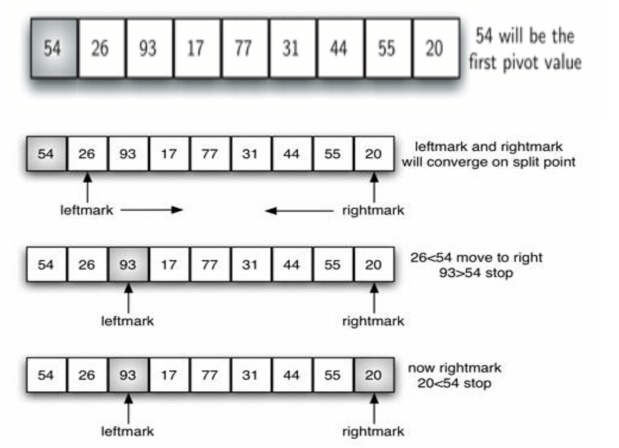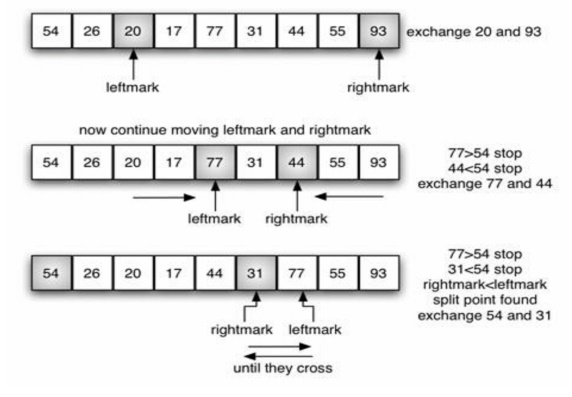Chapter: Object Oriented Programming and Data Structure : Sorting And Searching
Quick Sort
Quick Sort
The quick sort uses divide and conquer to
gain the same advantages as the merge sort, while not using additional storage.
As a trade-off, however, it is possible that the list may not be divided in
half. When this happens, we will see that performance is diminished. A quick
sort first selects a value, which is called the pivot value. Although there are many different ways to choose the
pivot value, we will simply use the first item in the list. The role of the
pivot value is to assist with splitting the list. The actual position where the
pivot value belongs in the final sorted list, commonly called the split point, will be used to divide the
list for subsequent calls to the quick sort. Figure shows that 54 will serve as
our first pivot value. Since we have looked at this example a few times
already, we know that 54 will eventually end up in the position currently
holding 31.


The partitionprocess will happen next. It
will find the split point and at the same time move other items to the
appropriate side of the list, either less than or greater than the pivot value.
Partitioning begins by locating two position markers—let’s call them leftmark
and rightmark—at the beginning and end of the remaining items in the list
(positions 1 and 8 in Figure below. The goal of the partition process is to
move items that are on the wrong side with respect to the pivot value while
also converging on the split point. Figure above shows this process as we
locate the position of 54.
We begin
by incrementing leftmark until we locate a value that is greater than the pivot
value. We then decrement rightmark until we find a value that is less than the
pivot value. At this point we have discovered two items that are out of place
with respect to the eventual split point. For our example, this occurs at 93
and 20. Now we can exchange these two items and then repeat the process again.
At the point where rightmark becomes less than leftmark, we stop. The position
of rightmark is now the split point. The pivot value can be exchanged with the
contents of the split point and the pivot value is now in place. In addition,
all the items to the left of the split point are less than the pivot value, and
all the items to the right of the split point are greater than the pivot value.
The list can now be divided at the split point and the quick sort can be
invoked recursively on the two halves.

The
quickSort function shown in CodeLens 7 invokes a recursive function,
quickSortHelper.quickSortHelper begins with the same base case as the merge
sort. If the length of the list is less than or equal to one, it is already
sorted. If it is greater, then it can be partitioned and recursively sorted.
Thepartition function implements the process described earlier.
QUICK SORT for PSEUDOCODE:
def quickSort(alist):
quickSortHelper(alist,0,len(alist)-1)
def quickSortHelper(alist,first,last):
if first<last:
splitpoint = partition(alist,first,last)
quickSortHelper(alist,first,splitpoint-1)
quickSortHelper(alist,splitpoint+1,last)
def partition(alist,first,last):
pivotvalue = alist[first]
leftmark = first+1
rightmark = last
done = False
while not done:
while leftmark <= rightmark and \
alist[leftmark] <= pivotvalue: leftmark = leftmark + 1
while alist[rightmark] >= pivotvalue and \ rightmark >=
leftmark:
rightmark = rightmark -1 if rightmark < leftmark: done = True
else:
temp = alist[leftmark]
alist[leftmark] = alist[rightmark]
alist[rightmark] = temp
temp = alist[first]
alist[first] = alist[rightmark]
alist[rightmark] = temp
return rightmark
alist = [54,26,93,17,77,31,44,55,20]
quickSort(alist)
print(alist)
Related Topics